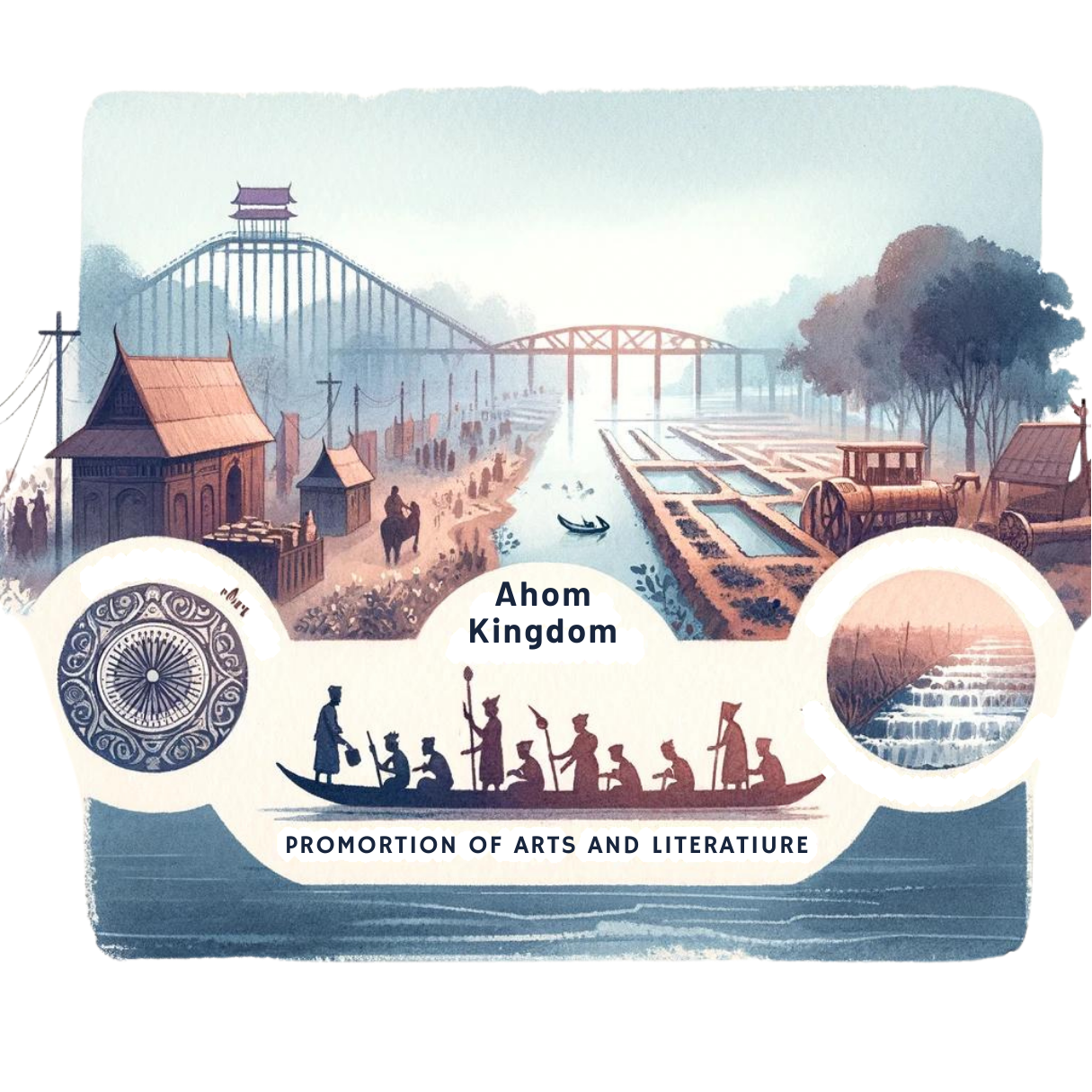The Ahom Kingdom, located in the Brahmaputra Valley of present-day Assam, stands as a remarkable example of resilience and adaptation in medieval Indian history. Established in 1228 by Sukaphaa, a Tai prince from present-day Yunnan, China, the Ahom dynasty ruled Assam for nearly six centuries. Their unique administrative practices and steadfast resistance to external invasions, particularly by the Mughals, highlight their significant role in the region’s history.

History of the Ahom Kingdom
The Ahom Kingdom’s origins trace back to Sukaphaa, who crossed the Patkai hills with his followers and established his capital at Charaideo. The early Ahom rulers expanded their territory through alliances and military conquests, gradually assimilating various indigenous communities and cultures into their fold.
Key milestones in the history of the Ahom Kingdom include:
- Establishment and Early Expansion (1228–1527): Under the early kings, the Ahom Kingdom consolidated power and expanded its territory through strategic marriages and alliances with local chieftains. The assimilation of local customs and traditions helped create a cohesive society.
- Consolidation and Centralization (1527–1603): During the reign of Suhungmung (1497–1539), also known as Dihingia Raja, significant administrative reforms were introduced, centralizing the kingdom’s governance. The Ahoms also fortified their military strength to defend against external threats.
- Golden Age (1603-1670): The period under the reign of Susenghphaa (1603-1641), also known as Pratap Singha, marked the zenith of Ahom power. The kingdom experienced political stability, economic prosperity, and cultural flourishing.
Unique Administrative Practices
The Ahom Kingdom’s administration was characterized by several unique and innovative practices that ensured its stability and longevity.
- Paik System: The cornerstone of the Ahom administrative structure was the Paik system, a form of corvée labor. Every male between the ages of 15 and 50 was registered as a Paik and assigned specific duties, such as agriculture, construction, or military service. The Paiks were organized into Khels (groups), which rotated their services. It ensured that no individual was overburdened and that labor was efficiently utilized.
- Decentralized Governance: The kingdom was divided into various provinces called Mouzas, each governed by a Borphukan. Local administration was managed by Gaonburhas (village headmen) and Mouzadars (revenue collectors), ensuring effective governance at the grassroots level.
- Land Revenue System: The Ahoms implemented a sophisticated land revenue system, assessing taxes based on land fertility and productivity. The revenue collected was used to maintain the kingdom’s infrastructure, including roads, temples, and fortifications.
- Military Organization: The Ahom military was well-organized and capable of mobilizing large forces quickly. The army included specialized units such as infantry, cavalry, and naval forces. The use of guerrilla tactics and knowledge of the local terrain gave them a strategic advantage over their adversaries.
Resistance to Mughal Invasions
The Ahom Kingdom is particularly noted for its resilience against multiple Mughal invasions. Their resistance was characterized by strategic military tactics, strong leadership, and effective use of the challenging Assamese terrain.
- Battle of Saraighat (1671): One of the most significant confrontations between the Ahoms and the Mughals was the Battle of Saraighat. Led by the legendary commander Lachit Borphukan, the Ahom forces defeated the Mughal army under Ram Singh I. The battle took place on the Brahmaputra River, where the Ahoms used their naval prowess to outmaneuver the Mughals. Lachit Borphukan’s leadership and the strategic use of riverine warfare played crucial roles in this decisive victory.
- Guerilla Warfare: The Ahoms effectively employed guerrilla warfare, leveraging their knowledge of the local geography. They used hit-and-run tactics, ambushes, and night raids to harass and weaken the larger Mughal forces.
- Fortifications and Defense: The Ahoms constructed numerous forts and defense structures along strategic points. These fortifications served as strongholds against invasions and provided secure bases for launching counterattacks.

Adaptation and Cultural Synthesis
The Ahom Kingdom’s success was also due to its ability to adapt and integrate various cultural influences.
- Cultural Assimilation: The Ahoms were adept at assimilating local cultures and traditions. They adopted Assamese as the court language. It integrated Hindu religious practices with their indigenous Tai traditions, leading to a unique cultural synthesis.
- Promotion of Arts and Literature: The Ahom rulers were patrons of art and literature. They encouraged the compilation of historical chronicles known as Buranjis, which documented the kingdom’s history, culture, and administrative practices. These texts provide valuable insights into the medieval history of Assam.
- Agricultural Innovations: The Ahoms introduced various agricultural innovations, including the construction of canals and embankments to control flooding and improve irrigation. These measures enhanced agricultural productivity and supported the kingdom’s economy.

Conclusion
The Ahom Kingdom’s history is a testament to its resilience and adaptability. Through unique administrative practices, strategic military tactics, and cultural assimilation, the Ahoms established a powerful and enduring kingdom in Assam. Their successful resistance against Mughal invasions and their contributions to Assamese culture and administration remain significant chapters in India’s medieval history. The legacy of the Ahom Kingdom continues to be celebrated for its remarkable achievements and enduring influence on the region’s history and culture.


